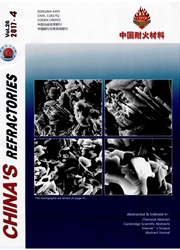

 中文摘要:
中文摘要:
Nowadays,it is a great challenge to reduce energy consumption and exhaust emission for human activities,in particular,high temperature industries.Among many efforts made to realize energy savings for high temperature furnaces and kilns,the use of high emissivity materials is considered to be an effective route to increase their thermal efficiency by enhancing heat transfer.Most materials with high refractoriness and superior chemical stability have weak infrared absorption and radiation properties;however,their emissivity in infrared regions(1 —25 μm) could be effectively increased by ion doping.This is attributed to three main mechanisms:1) distortion of the crystal lattice;2) increase of free carrier absorption; 3) formation of impurity energy level.In this paper,the development and advancement of various material systems with high emissivity including non-oxides and oxide based ceramics were reviewed.It is also suggested that the establishment of evaluation models or instruments for energy savings would be beneficial to design and application of high emissivity materials in various high-temperature environment.Furthermore,more efforts should be made on durability of high emissivity materials at high service temperatures and on the standardization of testing methods for emissivity.
 英文摘要:
英文摘要:
Nowadays,it is a great challenge to reduce energy consumption and exhaust emission for human activities,in particular,high temperature industries.Among many efforts made to realize energy savings for high temperature furnaces and kilns,the use of high emissivity materials is considered to be an effective route to increase their thermal efficiency by enhancing heat transfer.Most materials with high refractoriness and superior chemical stability have weak infrared absorption and radiation properties;however,their emissivity in infrared regions(1 —25 μm) could be effectively increased by ion doping.This is attributed to three main mechanisms:1) distortion of the crystal lattice;2) increase of free carrier absorption; 3) formation of impurity energy level.In this paper,the development and advancement of various material systems with high emissivity including non-oxides and oxide based ceramics were reviewed.It is also suggested that the establishment of evaluation models or instruments for energy savings would be beneficial to design and application of high emissivity materials in various high-temperature environment.Furthermore,more efforts should be made on durability of high emissivity materials at high service temperatures and on the standardization of testing methods for emissivity.
 同期刊论文项目
同期刊论文项目
 同项目期刊论文
同项目期刊论文
 期刊信息
期刊信息
